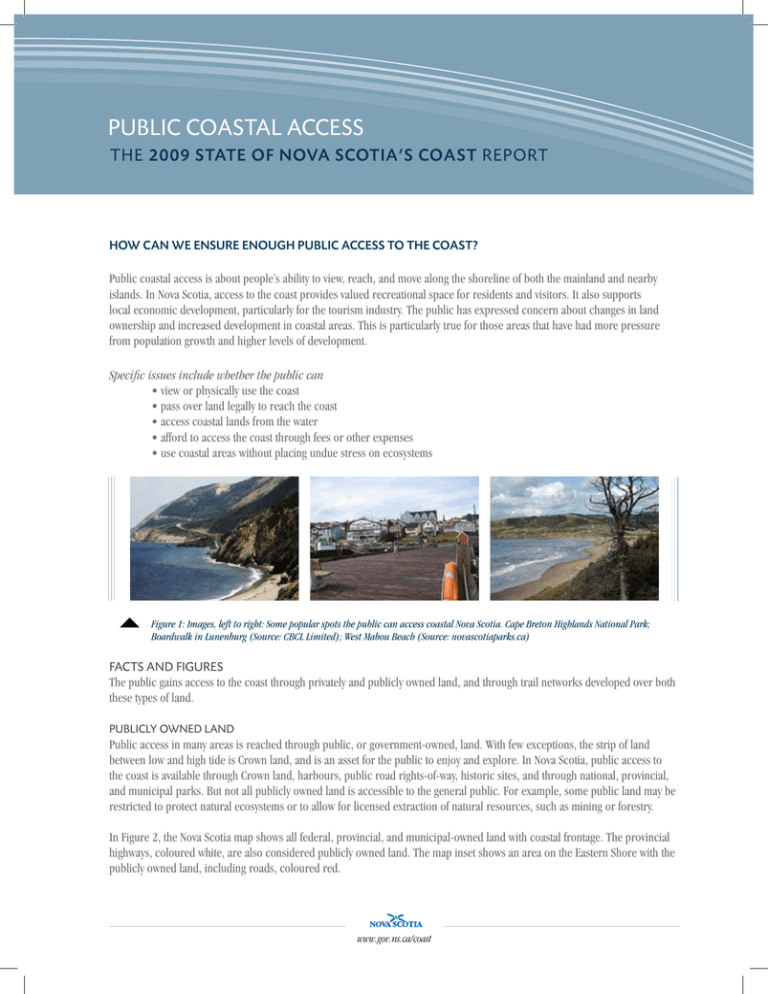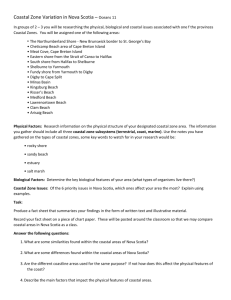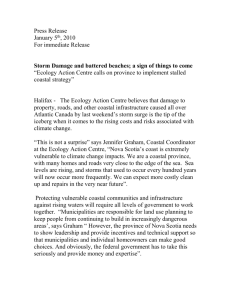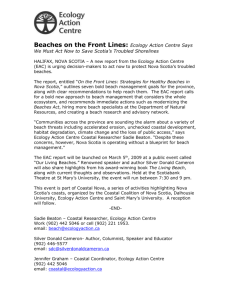Public Coastal Access - Government of Nova Scotia
advertisement

PUBLIC COASTAL ACCESS THE 2009 STATE OF NOVA SCOTIA’S COAST REPORT How can we ensure enough public access to the coast? Public coastal access is about people’s ability to view, reach, and move along the shoreline of both the mainland and nearby islands. In Nova Scotia, access to the coast provides valued recreational space for residents and visitors. It also supports local economic development, particularly for the tourism industry. The public has expressed concern about changes in land ownership and increased development in coastal areas. This is particularly true for those areas that have had more pressure from population growth and higher levels of development. Specific issues include whether the public can • view or physically use the coast • pass over land legally to reach the coast • access coastal lands from the water • afford to access the coast through fees or other expenses • use coastal areas without placing undue stress on ecosystems Figure 1: Images, left to right: Some popular spots the public can access coastal Nova Scotia. Cape Breton Highlands National Park; Boardwalk in Lunenburg (Source: CBCL Limited); West Mabou Beach (Source: novascotiaparks.ca) Facts and Figures The public gains access to the coast through privately and publicly owned land, and through trail networks developed over both these types of land. Publicly owned land Public access in many areas is reached through public, or government-owned, land. With few exceptions, the strip of land between low and high tide is Crown land, and is an asset for the public to enjoy and explore. In Nova Scotia, public access to the coast is available through Crown land, harbours, public road rights-of-way, historic sites, and through national, provincial, and municipal parks. But not all publicly owned land is accessible to the general public. For example, some public land may be restricted to protect natural ecosystems or to allow for licensed extraction of natural resources, such as mining or forestry. In Figure 2, the Nova Scotia map shows all federal, provincial, and municipal-owned land with coastal frontage. The provincial highways, coloured white, are also considered publicly owned land. The map inset shows an area on the Eastern Shore with the publicly owned land, including roads, coloured red. www.gov.ns.ca/coast Figure 2: Map of Nova Scotia showing public and private land in Nova Scotia. Approximately 13 per cent of the Nova Scotia coastline is publicly owned. Some examples include • two national parks that provide coastal access – Cape Breton Highlands National Park and the Kejimkujik Seaside Adjunct • several national historic sites with coastal mainland, island, and tidal river locations – Port-Royal, Fort Anne, Grand-Pré, Fort Beauséjour – Fort Cumberland, Canso Island, Fort McNab, York Redoubt, and the Fortress of Louisburg • lands surrounding certain lighthouses in the province, some of which remain in federal ownership and some of which have been transferred to community organizations • publicly owned wharves and ports • 71 provincial parks located in coastal areas that provide important public access to trails, beaches, boat launches, picnic facilities, and other recreational facilities • municipal parks, boardwalks, boat ramps, and piers which provide public access and important locations for community events, festivals, and services THE 2009 STATE OF NOVA SCOTIA’S COAST REPORT Privately owned land The public can also access the coast across privately owned land. They can ask for permission or pay the land owner. They can pay for a service provided on private coastal land, such as renting a hotel room and accessing the beach through hotel property. People can also purchase coastal property, ensuring private access for their families and guests. Coastal development can make access difficult, and it’s happening more frequently along roads or highways running parallel to oceanfront lots. As more lots are subdivided and land is developed, areas of the coast that people have traditionally and informally accessed have become more restricted. Trail networks Views across private property are another way that the public can access the coast, and views from roads and trails are generally plentiful. But restriction of views is an issue in Halifax, where most of the tall buildings are built. Trails throughout the province also provide access to coastal views, beaches, and wetlands. Nova Scotia has over 80 community trail associations and the Trans Canada Trail system. They work with all levels of government to develop, maintain, and promote individual and broader trail networks. Formal trails are relatively new to the province, but more are being developed than ever before. They ensure access to many different locations, including the coast. What Nova Scotians are doing now All levels of government, many interest groups, and individuals are involved in ensuring and protecting access to the coast. Several organizations acquire land for conservation purposes, which includes coastal lands with trails accessible to the public. Some active organizations include Ducks Unlimited Canada, the Nature Conservancy of Canada, Nova Scotia Nature Trust, Kingsburg Coastal Conservancy, and the Eastern Habitat Joint Venture. Two provincial departments, Natural Resources and Environment, are active partners in land acquisitions. Other groups have begun gathering information on public coastal access and have made it available online. For example, the Coastal Communities Network maintains a website, www.closetothecoast.ca, which displays a provincial map with links to information about harbours and wharves. The website has information on docking fees, nearby restaurants, shops, and attractions. Several departments and community organizations have developed the province’s Trails Nova Scotia website at www.trails.gov.ns.ca. It has information about access points to overland trails, coastal water trails, and sea kayak or canoe routes. Where are the information gaps? No record of public access points that is comprehensive or consistently maintained This makes it difficult to create an overall picture of provincial trends and the status of coastal access. No inventory of permitted pathways across private land The status or importance of these places for coastal access must be determined. Much of the conflict and public concern is about informal access across privately owned land. Many traditional pathways have been reduced or cut off as more land is developed and land owners no longer grant permission to cross their land. The Future: Some ways to ensure public access to the coast The Nova Scotia coast is long, and most people can see or access beaches and headlands with little difficulty. But patterns of land use and access are changing. Coastal land subdivision and residential development have restricted traditional access to beaches and coastal resources in some areas. At the same time, changes in recreational patterns have created new demands. Dramatic changes in working waterfronts have also opened up many areas to public enjoyment, including the waterfronts of Lunenburg, Mahone Bay, and Halifax. Better tracking and understanding of the changing patterns in coastal access is an important part of the sustainable use and management of our coastal areas. We can continue to achieve public access to Nova Scotia’s coasts in a sustainable manner in several ways. These include buying more public coastal lands, increasing incentives for private land owners to provide access, and continuing to develop trail systems. Further Reading Navarro, N.G. 2000. Public Waterfront Access: A Comparison of Integrated Coastal Management in Canada and the United States. Masters Thesis, School of Resource and Environmental Management, Simon Fraser University. Pogue, P. and Lee, V. 1999. “Providing Public Access to the Shore: The Role of Coastal Zone Management Programs”, Coastal Management 27: 219–237. Cameron, A.M. 1993. Your Land and the Law: A Landowner’s Guide to Real Property Law in Nova Scotia. Halifax: Nimbus Publishing. Nova Scotia. Voluntary Planning Task Force. 2001. Non-Resident Land Ownership in Nova Scotia. https://vp.gov.ns.ca/files/vp/shared/pubs/non-resland.pdf (December, 2001) THE 2009 STATE OF NOVA SCOTIA’S COAST REPORT www.gov.ns.ca/coast







